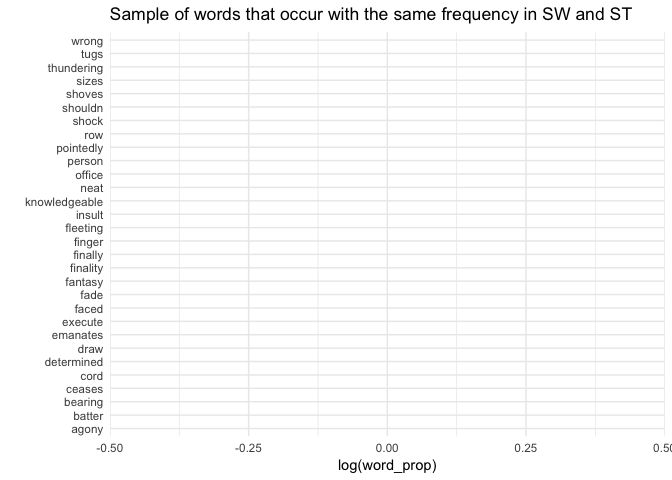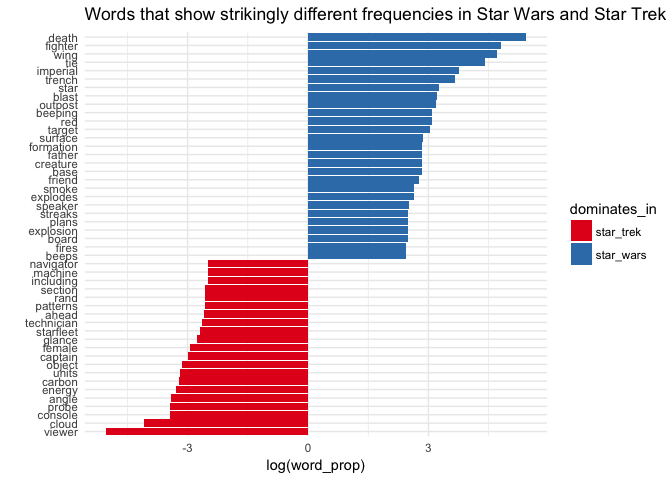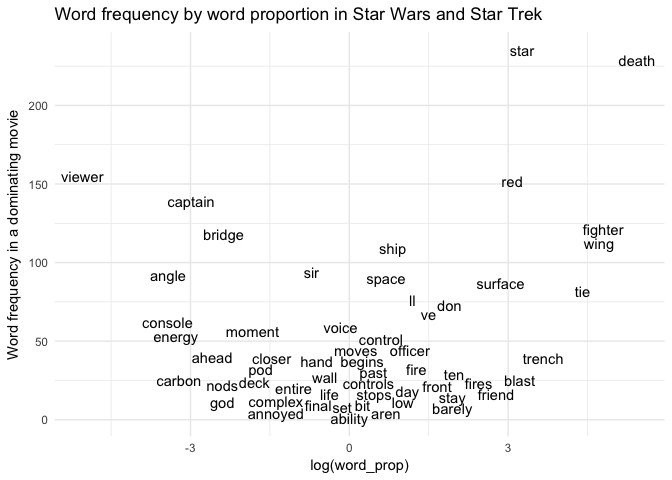It will go without saying that I’m super excited about the premiere of another Star Wars movie and I’m not an exception. This, together with with Piotr Migdal’s challenge posted on Data Science PL group on Facebook where he suggested comparing word frequencies between two different sources. It didn’t take me long to decide what source to choose! So in this short kand sweer blogpost I’m comparing word frequencies between two movie scripts: “Star Wars: The New Hope” (1977) and “Star Trek: The Motion Picture” (1979). I chose these two because of 1) the obvious “competition” going on between the two camps and 2) similar time they were first broadcast. Let’s get cracking!
Let’s load necessary packages:
library(rvest)
library(dplyr)
## Warning: package 'dplyr' was built under R version 3.4.2
library(tm)
library(tidytext)
## Warning: package 'tidytext' was built under R version 3.4.2
library(ggthemes)
library(ggplot2)
library(DT)
The first one, rvest, comes in handy in web-scraping text from the movie scripts (it’s amazing what you can get online for free these days):
swIV_url <-"http://www.imsdb.com/scripts/Star-Wars-A-New-Hope.html"
startrek_url <- "http://www.dailyscript.com/scripts/startrek01.html"
star_wars <- read_html(swIV_url) %>%
html_nodes("td") %>%
html_text() %>%
.[[88]]
star_trek <- read_html(startrek_url) %>%
html_nodes("pre") %>%
html_text()
str(star_wars)
## chr "\r\n\r\n\n\n\n STAR WARS\n\n Epis"| __truncated__
As you can see, the script texts are very messy, so I write a customised function to clean them up a bit:
clean_text <- function(x) {
x <- gsub("\\\n", " ", x)
x <- gsub("\\\r", " ", x)
x <- gsub("\\\t", " ", x)
x <- gsub("[[:punct:]]", " ", x)
x <- x %>%
tolower() %>%
removeNumbers() %>%
stripWhitespace()
x}
clean_star_trek <- clean_text(star_trek)
clean_star_wars <- clean_text(star_wars)
str(clean_star_wars)
## chr " star wars episode iv a new hope from the journal of the whills by george lucas revised fourth draft january lu"| __truncated__
That’s MUCH better! From here, we are only a few steps away from getting the desired word frequency tables:
data("stop_words")
sw_tokens <- clean_star_wars %>%
as_tibble() %>% # trasforming vector to tibble
rename_(sw_text = names(.)[1]) %>% # assign a column name
mutate_if(is.factor, as.character) %>% # convert it from factor to character
mutate(swt=unlist(sw_text)) %>%
unique() %>%
unnest_tokens("word", sw_text) %>% # break text down into single words
anti_join(stop_words) %>% # remove stop words
count(word, sort = TRUE) %>% # count word frequency and sort it in decreasing order
rename(sw_n = n)
st_tokens <- clean_star_trek %>%
as_tibble() %>%
rename_(st_text = names(.)[1]) %>%
mutate_if(is.factor, as.character) %>%
mutate(stt=unlist(st_text)) %>%
unique() %>%
unnest_tokens("word", st_text) %>%
anti_join(stop_words) %>%
count(word, sort = TRUE) %>%
rename(st_n = n)
sw_tokens
## # A tibble: 3,385 x 2
## word sw_n
## <chr> <int>
## 1 luke 726
## 2 int 314
## 3 han 269
## 4 star 235
## 5 death 229
## 6 threepio 217
## 7 cockpit 196
## 8 ben 176
## 9 ext 167
## 10 vader 162
## # ... with 3,375 more rows
TA-DA! Our tables are ready and squeky clean :) Now, I’ll use inner_join() to narrow down the data to only those words that the two scripts have in common. To compare the frequencies I’ll use a variable called log_word_prop: logarithm of the proportion between Star Wars and Star Trek word frequency. This means that the more positive the value, the more drastic the difference in frequency it is in favour of Star Wars. On the other hand, the more negative the value, the more commonly it was used in Star Trek (in comparison to Star Wars).
final_tokens = sw_tokens %>%
inner_join(st_tokens) %>%
mutate(log_word_prop = round(log(sw_n / st_n),3),
dominates_in = as.factor(ifelse(log_word_prop > 0, "star_wars", "star_trek")))
final_tokens
## # A tibble: 1,293 x 5
## word sw_n st_n log_word_prop dominates_in
## <chr> <int> <int> <dbl> <fctr>
## 1 int 314 110 1.049 star_wars
## 2 star 235 9 3.262 star_wars
## 3 death 229 1 5.434 star_wars
## 4 ext 167 49 1.226 star_wars
## 5 red 152 7 3.078 star_wars
## 6 fighter 121 1 4.796 star_wars
## 7 wing 112 1 4.718 star_wars
## 8 ship 109 48 0.820 star_wars
## 9 space 90 45 0.693 star_wars
## 10 surface 87 5 2.856 star_wars
## # ... with 1,283 more rows
And we can finally visualise our findings: first, let’s have a quick glipse on what words occured in pretty much the same frequency in both movies:
set.seed(13)
final_tokens %>%
filter(abs(log_word_prop) == 0) %>%
arrange(desc(sw_n)) %>%
sample_n(30) %>%
ggplot(aes(x = reorder(word, log_word_prop), y = log_word_prop, fill = dominates_in)) +
geom_bar(stat = "identity", show.legend = FALSE) +
theme_minimal() +
coord_flip() +
xlab("") +
ylab("log(word_prop)") +
scale_fill_brewer(palette = "Set1") +
ggtitle("Sample of words that occur with the same frequency in SW and ST")

I must say, I expected this most similar vocabulary to be much more technical. At the same time, this time according to expectations, those words reflect action and drama in both movies: things cease, emanate and shove, people shock, experience agony and are determined and knowledgeable.
What about most polarizing words? I chose to show the words that were at least 12 times (log_word_prop > 2.4) more common in one movie than the other. What are they?
final_tokens %>%
filter(abs(log_word_prop) > 2.4) %>%
filter(!word %in% c("ext", "int")) %>%
ggplot(aes(x = reorder(word, log_word_prop), y = log_word_prop, fill = dominates_in)) +
geom_bar(stat = "identity") +
theme_minimal() +
coord_flip() +
xlab("") +
ylab("log(word_prop)") +
scale_fill_brewer(palette = "Set1") +
ggtitle("Words that show strikingly different frequencies in Star Wars and Star Trek")

Haha! You may not be surprised that the most Star Wars-y vocabulary is full of words like death, star, imperial or even father, but I didn’t expect female or cloud to be THAT much more present in Star Trek! Some things never cease to surprise even most determined and knowledgeable people, even if they have assistance of imperial technician ;-)
UPDATE!!
After Piotr’s suggestion, I decided to play a bit with ggplot’s excellent geom_text(). This little tweak can give you surprising inisghts into the Word Battle matter! Below I plotted the more dominant frequency of a given word againts a relative difference in word proportion:
final_tokens %>%
mutate(dominant_freq = as.numeric(ifelse(sw_n > st_n, sw_n, st_n))) %>%
filter(!word %in% c("ext", "int")) %>%
ggplot(aes(log_word_prop, dominant_freq, label = word)) +
geom_text(check_overlap = TRUE) +
theme_minimal() +
ylab("Word frequency in a dominating movie") +
xlab("log(word_prop)") +
scale_fill_brewer(palette = "Set1") +
ggtitle("Word frequency by word proportion in Star Wars and Star Trek")

Not a bad start! A much more appealing - although a bit less readable - look can be achieved with geom_label():
final_tokens %>%
mutate(dominant_freq = as.numeric(ifelse(sw_n > st_n, sw_n, st_n))) %>%
filter(!word %in% c("ext", "int")) %>%
ggplot(aes(log_word_prop, dominant_freq, label = word)) +
geom_label(aes(fill = dominates_in), colour = "white", fontface = "bold") +
theme_minimal() +
ylab("Word frequency in a dominating movie") +
xlab("log(word_prop)") +
scale_fill_brewer(palette = "Set1") +
ggtitle("Word frequency by word proportion in Star Wars and Star Trek")
